During my tour of duty in Vietnam, I went out on a number of motor convoys delivering or picking up supplies of one kind or another. Our small convoys normally left the Phu Cat airbase and headed east to the Qui Nhon Army base, with a few stops in between. Qui Nhon was on the coast, and I always enjoyed seeing the ocean; a part of Vietnam that the war didn’t own. On rare occasions we headed west towards An Khe, traveling deeper into the Central Highlands of South Vietnam. This is about one of those runs west.
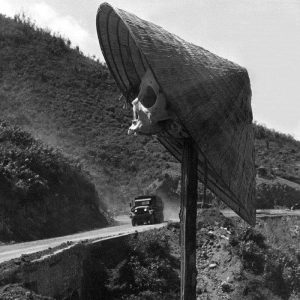
There were only 2 roads in our area; Hwy 19 ran east and west, and Hwy 1, aka “the highway of death”, ran north and south.
Leaving Phu Cat was always an untold adventure, anything could and sometimes did happen along those small dusty roads. We were accosted by VC (Vietcong) a few times, hostile villagers a few times and local militia trying to shake us down for a few bucks a few times. We had been fortunate in that we suffered no casualties, except for one night convoy where the lead vehicle, an army jeep, hit a booby trap in the road. That night saw two casualties, two badly damaged vehicles and the convoy aborted.
On many trips we would encounter large U.S. Army convoys passing us or heading in the opposite direction. These convoys sometimes consisted of a dozen trucks or more with a few large gun trucks leading the way. They would sometimes make sport of us by running our smaller convoy off the road or harassing us in some way. We didn’t take it personally, however neither did we enjoy it.
On this particular day, however, we headed west on highway 19 with a load we were to deliver to an army unit who were working with the “Yards”. The Yards, or Montagnards were “hill people” who inhabited the mountainous area of Central South Vietnam. Montagnard is a French term meaning “mountain people”, however the so named people were not all one and the same. I also recall the Montagnards being referred to as the Degar.
There were actually around thirty aboriginal tribes of these “mountain people”, originating from three different linguistic groups inhabiting an area about one quarter the size of California. These were primitive hunters and farmers who moved from one area to another depending on resource availability and living conditions.
Some of the tribes were peaceful, maintaining good relations with other tribes, while other tribes were very aggressive taking what they needed by force. But all of the tribes had a tenuous relationship with the ethnic Vietnamese, who viewed them as a nuisance taking up valuable land and resources that they themselves coveted.
The Religious Angle
During the French colonial period, the French did their best to convert these pagan tribes to Catholicism. Later, the American clergy exerted much effort in converting these same tribes into the Protestant religion. This played well with the tribes because they were constantly in conflict with the ethnic Vietnamese, who were primarily Buddhist. (Although even after converting, the tribes never abandoned their pagan habits and rituals) This religious conversion also put the tribes at odds with the Vietcong and North Vietnamese, who replaced worship of religion with worship of the central committee.
So due to cultural, religious, economic and ethnic differences, the tribal people of Vietnam maintained hostile relations with the Vietnamese government, both before and after the fall of Saigon.
And things haven’t changed for the better for the tribes, as the communists today continue in their attempt to “gentrify” the Central Highland tribes, pushing them around, confiscating their land and marginalizing them. Their fate is not unlike the fate of Native Americans, who experienced the same treatment, (though worse) by non-native late comers.
For the average American GI in Vietnam, the tribes were a source of mystery, folklore and souvenirs. However, the American military did manage to take advantage of the tribe’s natural animosity toward the Vietcong and NVA. (North Vietnamese Army) American Special Forces recruited and trained them for extensive guerilla warfare. The fierce fighting tribesmen performed a valuable service for the Americans and South Vietnamese, though at times, they proved difficult to manage, sometimes changing loyalty on a daily basis. But for the most part they were an important asset in the fight against the communists.
Though westerners saw the tribes as one and lumped them all together as Montagnards, the tribes separated themselves by origin, history, and blood relation. There were three different tribes very close to the main base at Phu Cat: the Haroi, the Bahnar, and the Rade. I have no idea which ones were which, regarding any of the ones I came in contact with.
A Successful Mission
On the aforementioned convoy carrying supplies intended for the “Yards”, we fulfilled our mission. As we finished up and milled about, we interacted with some of the American soldiers and Montagnards who the goods were intended for. Though fierce looking tribesmen, the Yards had their eye on the product we always carried with us and often traded with other Vietnamese while out on the road…. American cigarettes and aviator sunglasses.
In exchange for cartons of smokes and shades, the Yards gave us about a half dozen crossbows, a stuffed mongoose and cobra in fighting position, and some of the nastiest beer I’ve ever tasted; even worse than the Vietnamese “33”, which was about five steps down from our usual ration of Black Label.
We also had to grease the palms of the grunts who were handling the transactions, so we paid dearly for the spindly crossbows and crappy beer. We hoped to sell the mongoose and cobra mount back at the base for a princely fee, in order to make up for the fleecing we took on the smokes and shades. Although the Montagnards looked like cavemen from the stone age, they proved to be shrewd traders; every bit as cagey as the Vietnamese “cowboys” we often dickered with outside the Phu Cat main gate and out on the road. Oh, the vagaries of life for the modest entrepreneur.
The Aftermath
Like other Vietnamese who directly assisted the Americans during the war, the Montagnards were very much in peril after the fall of Saigon. Many fled to Cambodia, and around 2,000 were resettled in the United States, primarily in North Carolina, contributing to the melting pot that we are. America the beautiful.
***
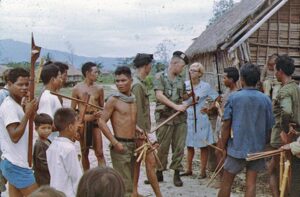
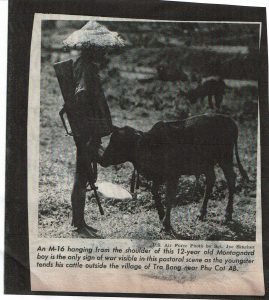
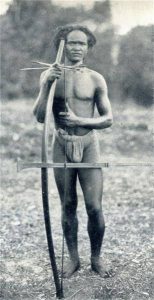
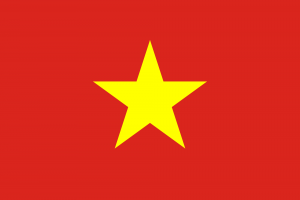
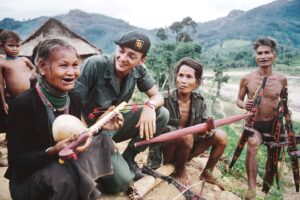
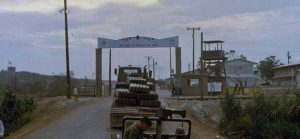
Joe,
‘Nuther great story! Thanks for posting!!!
I enjoyed the comparison to the ole Black Label. HaHaHa
Thanks Jim!
Good post Joe,
In my book, I describe an ambush of one of the convoys that I was on in the exact area that you just wrote about. I also have some photos of the Central Highland’s Montagnards that I’ll be glad to send you if you want.
Thanks for sharing your interesting stories.
Robert Kuhn
Thanks Bob. I would love to see your photos.
Pics sent Joe. Enjoy!
Photo of boy and cattle by Sgt Joe Sanchez. Joe and I were stationed together at Phu Cat air base with detachment 16, 600 photo squadron. I remember that photo from over 50 years ago.
Good article. Hand many dealings with the Montagards
Thank you David
A great read, Brother! Totally enjoyed every word. Keep on a’writtin’ !!
Thank you Steve, hope to do so, long as the creek don’t rise and the sun does shine!
Good story, Joe. I’ve always found the Montagnards interesting and their fate at the hands of the communists tragic. Great to read an up-close and personal story involving interacting with them. Well told with interesting details and insights. Thanks for posting.
Thanks Jerry.
Are you familiar with the Cambodia Corps? The founder lived here in Savannah, GA, Tommy Daniels III and passed away in 2023. https://www.cambodiacorps.org/
I have included a little bit of information about the organization.
Mission Statement/ Vision Statement
To educate poor Montagnard youth through scholarships,
helping the Montagnard help themselves.
A Montagnard Community with an equal voice, able to determine their own future.
Thank you for all you have done through the years. I always learn something from your posts!
Kindest regards,
Rebecca
Thank you for the information Rebecca, I am happy to see the Montagnards receiving this help. It is of interest to myself, and no doubt many of my readers.
And thank you for the kind words.
Great article, Joe! I used to ride my Harley with the Patriot Guard Riders and will occasionally join then via cage (car) for funerals and burials in this western NC area. A few years ago we escorted bus loads of Yards through the mountains to a small town in Eastern Tennessee to bury one of their esteemed officers. Every man and woman was dressed completely in black, very reverent and had white carnations as I recall. We stood a flag line and quietly left before their ceremony. It was an honor to be part of their lives if even for a short time.
Thanks Ric, and thanks for sharing, that had to be some experience.
Great read. The Yards are a fascinating people, it’s a real shame there’s so little accessible info on them (relatively speaking, anyway).
Thanks Will, they were a fascinating people indeed.